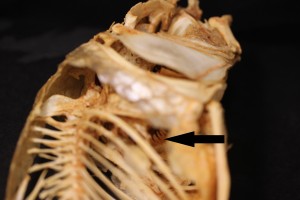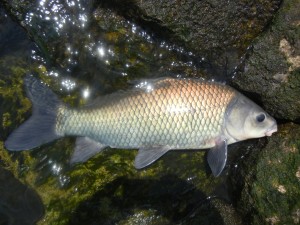Comparative anatomies of skeletons stored at the OSU Museum Fish Division can be studied to reveal information on the sort of ecological niches a particular species occupies. One example is the feeding niche that various sucker fish species exploit. Based on structures of their throat teeth and the type of prey items retrieved from their digestive tract it would appear that buffalo and carpsucker species use their fine, comblike teeth for sieving their prey, while suckers with larger teeth (most redhorses, hogsuckers, spotted suckers) are said to “masticate” their soft prey, and finally those with the sturdiest teeth are able to shatter the hard shells of molluscs.
The photo below shows the anterior portion of a Silver Redhorse skeleton (OSUM 101341), with an arrow pointing to the pharyngeal tooth arch (position indicted by arrow) located at the rear of the gill basket.
There are 16 extant species of sucker fishes in Ohio’s waters. Images of four of those species with pharyngeal tooth arches removed from some of our skeletons are shown below.
Spotted Sucker, Minytrema Melanops. Photo by Brian Zimmerman.
The Spotted Sucker has been reported to feed on organic fragments, diatoms, copepods, cladocerans, and midge larvae.
Smallmouth Buffalo, Ictiobus bubalus.
Smallmouth Buffalo suckers with their relatively delicate teeth feed on diatoms, dipteran larvae, copepods, cladocerans, ostracods, bryozoans, and incidental algae attached to bottom substrates.
Shorthead Redhorse, Moxostoma macrolepidotum. Photo by Ben Cantrell.
Shorthead Redhorse stomach contents have revealed their diet to consist primarily of midge, mayfly and caddisfly larvae.
River Redhorse Moxostoma carinatum. Photo by Uland Thomas.
The River Redhorse has the sturdiest teeth of the four sucker species’ teeth shown here, so much so that they are capable of cracking the shells of bivalve molluscs and snails.
For comparison, inserted below is a photo of the molariform pharyngeal teeth from a Freshwater Drum. The drum is primarily a carnivore, its diet comprised more extensively of bivalve mollusc and gastropod shells, while the omnivorous sucker fishes find most of their food by grazing the bottom of streams and lakes, sifting sand and gravel to find their little morsels.
About the Author: Marc Kibbey is Assistant Curator of the OSUM Fish Division.








